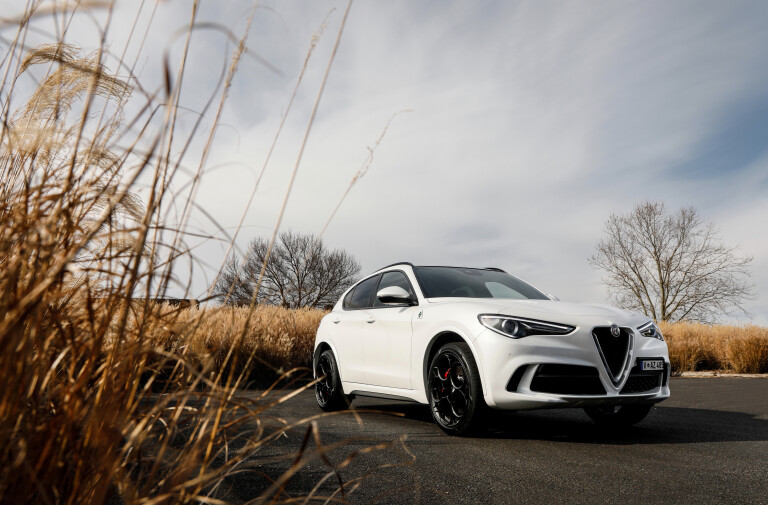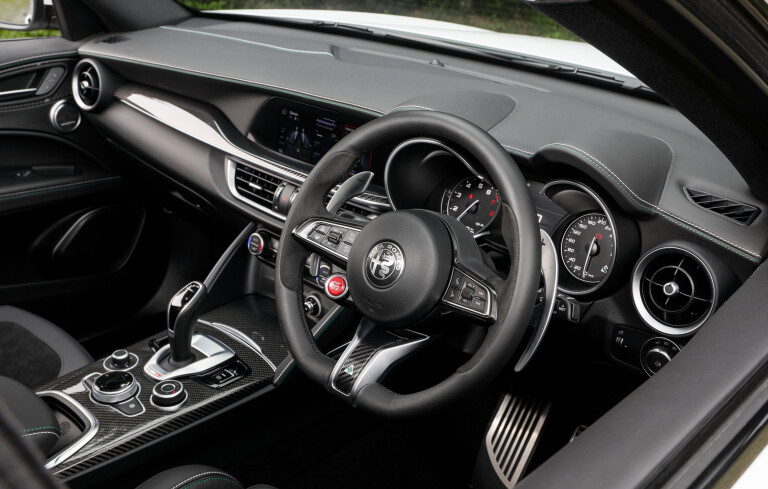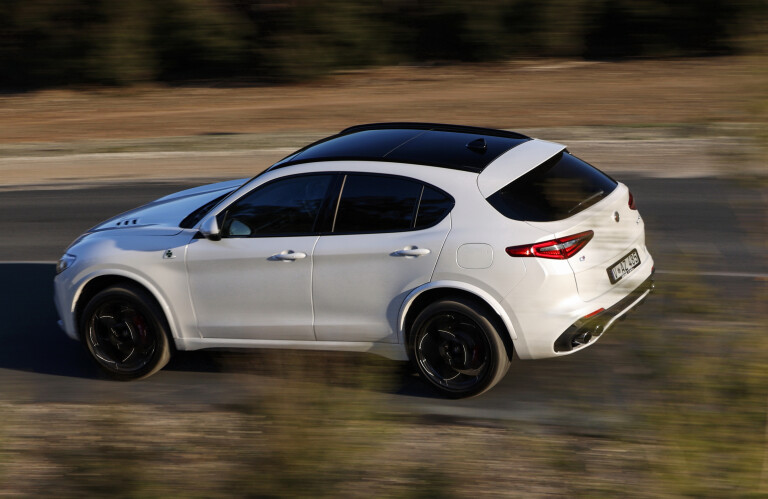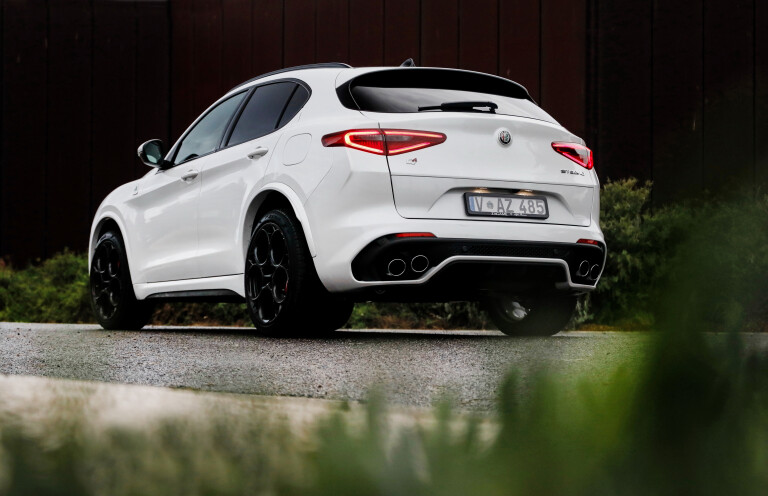
Things we like
- Howling V6
- Sleek aesthetics
- Improved infotainment and materials
Not so much
- Neurotic controls
- Unresolved driver aids
- Lurching auto handbrake
It shouldn't matter, but it does. Like people, cars only get one chance to create a favourable first impression and, if you’re asking the thick end of $150K for one, they’ve got a high bar to clear. Alfa Romeo’s Stelvio Q was a car with many admirable qualities, but sit inside for a couple of minutes and your instant take away from it was that the engine and underpinnings must be costing you a pretty penny because the budget certainly never went on the interior.
That first handshake with the Stelvio Q was always tinged with disappointment. It left you with the nagging suspicion that here was a vehicle wearing a lot of dress up but never avoiding some fairly proletarian roots. Cheap interior plastics, an infotainment system that might have had a $20K Kia preparing its excuses and a fairly rudimentary skim of electronic safety systems again left you figuring that the Stelvio needed to drive really well in order to muscle its way into contention. This needed to change for the facelift.

Combine that with the €5 billion investment into the non-electrifiable Giorgio platform that underpins the Giulia, Stelvio and absolutely nothing else, and it’s clear that no matter how successful the 2021 update of Alfa’s mid-size SUV proves, it’ll never be able to repay its debts. Sergio Marchionne’s breathtaking gamble fell on its face, new owners Stellantis looking instead to its STLA large vehicle architecture for future models.
You’d expect this 2021 version to be significantly different in order to change that script, but Alfa Romeo has instead decided not to radically alter the recipe and, as such, the changes are relatively modest. The cabin’s come in for a refresh, there are some additional safety systems and the drive modes have been tweaked. Unfortunately, it no longer remembers what mode you were previously in before the car was keyed off.
The price has also been given a haircut, coming down to $146,900, almost on a par with the comparatively limp-wristed 324kW Porsche Macan Turbo at $145,000 and a long way south of the Mercedes-AMG GLC63 S at $175,900. I reckon it’s better fun than both of them. The Stelvio Q always seems to have a mischievous glint about it; it eggs you on to enjoy that zone above 5000rpm where the bi-modal quad exhaust parps fruitily and races to the 7400rpm redline.

"Alfa waited for the cash registers to ker-ching but something happened. The public never really bought it"
Switch the ‘dna’ drive mode selector into Dynamic, take control of the elegant fixed paddle shifters, find the right road and you’ll have a great time, challenging yourself to get on the power earlier and earlier through corners. It’s a very specific challenge though and I’ve come to a conclusion about the Stelvio. There are those drivers who love a car that’s beautifully set up and which either is or has been moulded to suit their driving style. Then there are those drivers who see it as a challenge to mould their driving style to the quirks or shortcomings of the vehicle they’re driving. The former might struggle with the Stelvio. It has a lot of ‘characteristics’.
Whether it’s the sharp brake pedal, the uncouth parking brake release, the livewire steering or the cornering attitude that encourages you to jink it into a corner and then rectify what happens thereafter, it’s not a vehicle that feels natural to drive quickly and smoothly. A major plus is the ability to adjust the damping independently of drive mode but one trend I’d like to see junked is a Race mode which switches the ESC safety net off. That should be a driver’s decision based on the prevalent conditions, not Alfa’s, especially with such a rear-biased powertrain.
You expect the Stelvio Q to feel like a Giulia on stilts that has been gifted the occasional benefit of all-wheel drive, but something is lost in the process, despite engineer Roberto Fedeli’s ambitious aim to make the Stelvio feel exactly like the Giulia. Call it cohesion, flow, whatever you like, the fact remains that the Stelvio’s dynamics never feel as polished or as exploitable as the Giulia. That’s physics for you.

Perhaps it’s an unreasonable expectation. We wouldn’t expect a GLC 63 to feel like a C63 but with no Giulia wagon available, Alfa has, in effect, created that expectation itself. On a challenging road and judged in pure dynamic effectiveness, the Stelvio is one of the very best sporting SUVs at any price. I’d probably put it almost on par with the latest BMW X3M/X4M, but given that it retails for $11K less than the X3M and comes with a five rather than a three-year warranty, it does enough to eke a niche.
Thing is, most don’t buy sports SUVs purely on the way they can dissect a hill route. Alfa Romeo has somewhat belatedly recognised this fact and the latest Stelvio does a better job than before of staving off buyer’s remorse. The cabin now feels worthy of the price point, with better quality materials used in key areas and a Marelli-designed tile-based infotainment screen that is easy to use and offers fuss-free smartphone mirroring.
Alfa has also built in Level Two driver aids such as traffic-sign recognition with intelligent speed control, traffic jam assist (where the Stelvio holds station by monitoring both lanes and surrounding vehicles)active blind-spot assist and driver attention assist.

Some of the more recent safety features still require a bit of finessing, with the active cruise control a little finicky to set speeds. Indicate out after an overtaking car on a freeway and the system will accelerate the car fiercely as soon as you operate the indicators and then snatch at the brakes sharply once you’re into the adjacent lane and the radar has acquired the car receding in front of you. Like many of the Stelvio’s odd calibrations, you learn to drive around it.
It’s a shame that these peccadilloes exist because the Stelvio does what all good Alfa Romeos do: they make you want to like them. The beautiful alloy wheel design, the evocative cloverleaf wing crests, the elegant, cool-touch shift paddles, the fact that knocking the shift lever forwards plucks a lower gear in the 8HP75 transmission, the beautifully bolstered seats, the huge P Zero tyres, and the fact that there’s a Race mode are all things that point you in the direction of giving the Stelvio the benefit of the doubt every time that doubts arise.

And they will, despite Alfa’s belated efforts to tamp down buyer’s remorse. It would be the easiest thing for me, as editor of MOTOR, to give the Stelvio a solid recommendation based purely on the way that it drives, but there are caveats to consider. The way the interior squeaks and creaks will be enough to deter some. The supervision screen that produces conflicting nav instructions to the main screen is infuriating, blotting out the digital speedo in the process. The fact that it misses out on gear like a head-up display or wireless smartphone mirroring may have some thinking that the latest round of updates don’t really go far enough. Read the runes and it’s clear that Alfa Romeo knows that appealing to drivers alone isn’t a strategy that will keep the company hale and hearty. Its cars need to deliver broader appeal in order to make conquest sales.

The 2021 changes do make the Stelvio Q a better vehicle than before but it still lacks a certain sheen of cohesion in its execution. Its highs are extremely high indeed and its lows are no longer anything like as egregious. That will be enough for some, who are drawn to the most charismatic sports SUV money can buy but have previously been deterred by its rough edges. If you subscribe to the philosophy that life’s too short to be boring, you know what to do.
2021 Alfa Romeo Stelvio Q specs
| Body | 5-door, 5-seat SUV |
|---|---|
| Drive | all-wheel |
| Engine | 2981cc V6, DOHC, 24v, twin-turbo |
| Bore/Stroke | 86.5 x 82.0mm |
| Compression | 9.3:1 |
| Power | 375kW @ 6500rpm |
| Torque | 600Nm @ 2500-5000rpm |
| Weight | 1830kg |
| Power-to-weight | 205kW/tonne |
| Transmission | 8-speed automatic |
| Suspension | double wishbones, adaptive dampers, anti-roll bar (f); multi-links, adaptive dampers, anti-roll bar (r) |
| L/W/H | 4701/1955/1681mm |
| Wheelbase | 2818mm |
| Tracks | 1622/1675mm (f/r) |
| Steering | electrically assisted rack-and-pinion |
| Brakes | 360mm ventilated/drilled discs, 6-piston calipers (f); 350mm ventilated/drilled discs, 4-piston calipers (r) |
| Wheels | 20.0 x 9.0-inch (f); 20.0 x 10.0-inch (r) |
| Tyres | Pirelli P Zero, 255/45 R20 (f); 285/40 R20 (r) |
| Price | $146,900 |

Things we like
- Howling V6
- Sleek aesthetics
- Improved infotainment and materials
Not so much
- Neurotic controls
- Unresolved driver aids
- Lurching auto handbrake



COMMENTS